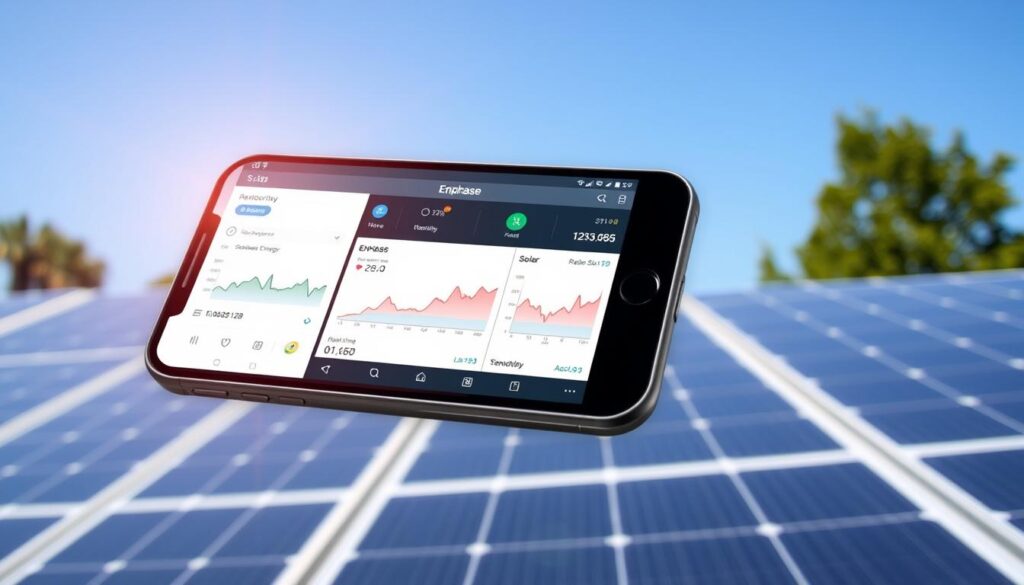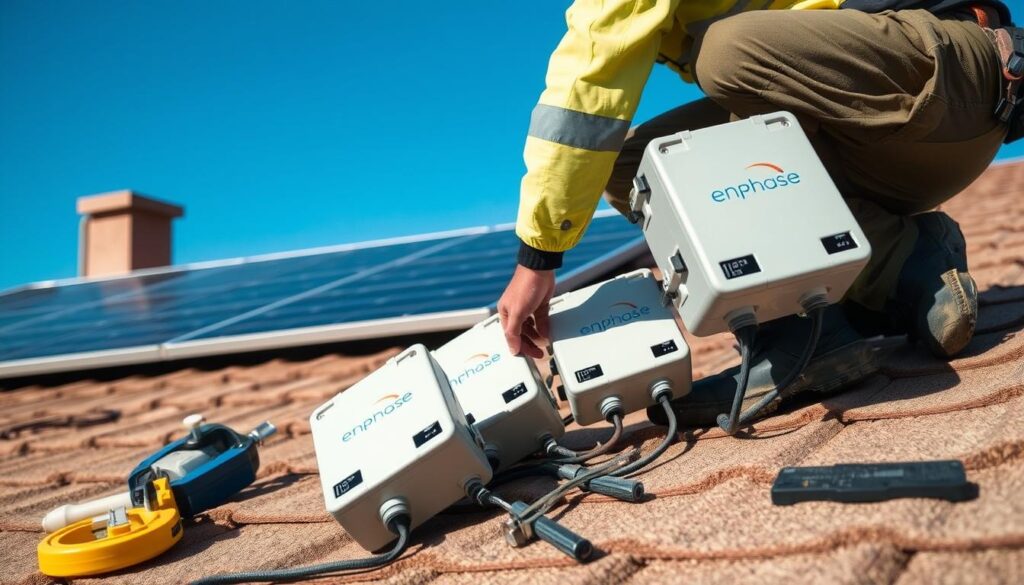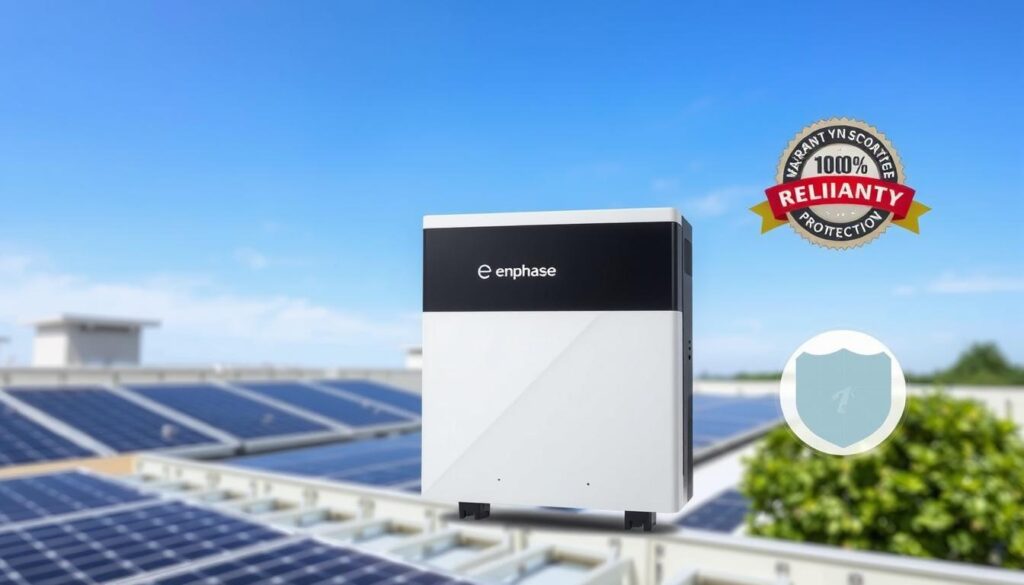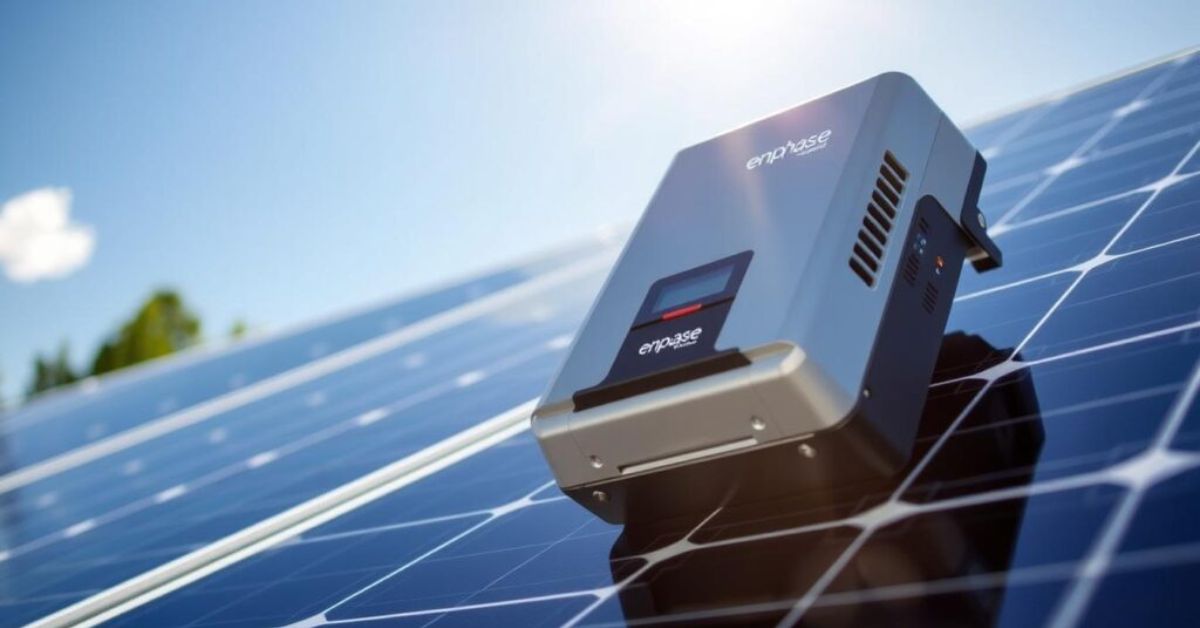Enphase microinverters are changing how we use solar energy. They offer new ways to make solar power more efficient. These inverters help optimize each solar panel, leading to better energy capture and system reliability.
In this article, we’ll examine eight key features of Enphase micro-inverters. These features make them a top choice for home solar systems and help homeowners get the most out of their solar energy.
Key Takeaways
- Enphase microinverters enhance individual panel performance for increased energy yield.
- They are a leading technology in clean energy solutions across residential settings.
- Optimized energy capture can significantly reduce electricity bills.
- The reliability of Enphase microinverters contributes to a stable energy supply.
- Each micro-inverter operates independently, minimizing the impact of shading and obstructions.
Understanding Micro Inverter Technology
Micro inverter technology changes how solar power systems work. It turns direct current (DC) from solar panels into alternating current (AC) for each panel, improving each panel’s performance and the system’s overall performance.
Micro inverters are different from traditional string inverters. They let each panel work alone. So, if one panel is shaded or dirty, it won’t stop the others from working well. This design helps get more energy and lose less, especially in shaded areas.
Knowing about micro inverter technology shows its big benefits. It leads to more energy and better system performance. This makes it a great choice for those looking into solar power systems.
| Feature | Micro Inverter Technology | Traditional String Inverter |
|---|---|---|
| Operation | Per-panel basis | Multi-panel connection |
| Shading Impact | Minimal impact | Significant impact |
| Energy Harvest | Higher energy production | Lower energy production |
| System Efficiency | Enhanced inverter efficiency | Standard inverter efficiency |
The Role of Enphase Micro Inverters in Solar Power Systems
The enphase micro inverter is a big step forward in solar energy systems. It works differently than old string inverters. Each solar panel can work its best, even if others are shaded or not facing the sun right.
The Enphase Envoy communications gateway is key. It lets users see how each panel is doing in real-time. This helps find problems fast and keeps the system running smoothly.
In short, the phase micro inverter makes solar systems better. The Envoy gateway helps make sure the system works its best.
Advantages of Using Enphase Micro Inverters
Enphase microinverters are a top pick for many solar fans. They boost energy efficiency by making each solar panel work better, which means more energy, especially in shady spots where old inverters falter.
They also make systems more reliable. Since each panel works alone, a problem with one doesn’t stop the whole system. This keeps the energy flowing without interruptions.
Smart solar tech is another big plus. Enphase inverters support battery storage, making energy storage easier. This boosts energy freedom and prepares for future tech upgrades.
Installing them is easy, too. Their small size makes setup simple and quick. This saves money and time, adding to their appeal in the solar world.
- Individual optimization of each solar panel
- Reduced risk of entire system failure
- Integration with battery storage options
- Flexible installation design
| Feature | Benefit |
|---|---|
| Panel Independence | Minimizes overall system failure risk |
| Energy Production Optimization | Increases overall energy output |
| Compatibility with Battery Storage | Enhances future readiness for energy needs |
| Easy Installation | Reduces labor and installation costs |
Enhanced Energy Efficiency of Enphase Micro Inverters
Enphase microinverters are known for boosting energy efficiency in solar systems. They let each solar panel work on its own, even in tough conditions like shade. This makes them better than traditional string inverters.
Enphase systems capture more energy, leading to more power overall. They can produce up to 20% more energy in shaded areas than old setups. This means big savings for those using solar power at home.
Here’s a table comparing Enphase microinverters with traditional string inverters:
| Feature | Enphase Micro Inverters | Traditional String Inverters |
|---|---|---|
| Energy Yield in Partial Shade | Up to 95% efficiency | Around 75% efficiency |
| System Monitoring | Per-panel monitoring | Overall system monitoring |
| Impact of Panel Orientation | Minimal impact | Significant impact |
| Installation Complexity | Easy, module-level installation | More complex, requiring optimization |
Real-life examples show how well Enphase micro inverters work. Homeowners have seen big boosts in their energy production. This shows that Enphase is a top choice for homes and businesses.
Enphase Micro Inverter Compatibility with Solar Panels
Knowing about enphase micro inverter compatibility with solar panels is key. It helps get the most energy and efficiency. Enphase microinverters work well with many solar panel brands and models, ensuring top performance.
Choosing the right micro inverter for your solar system is important. It must match the inverter specs to the panel needs. This ensures each solar panel inverter works well, turning sunlight into electricity efficiently.
Enphase microinverters are great for new setups or updating old systems. Homeowners can be sure Enphase will work with many solar panels, no matter their size or maker. This makes sure customers get the most out of their solar investment.
Monitoring Capabilities of Enphase Energy Solutions
The Enphase monitoring app is a powerful tool for homeowners. It helps them optimize their solar power systems. This app gives users real-time insights into energy production and system efficiency.
It also shows historical usage patterns. The app works well with the Enphase Envoy communications gateway. This makes it better at analyzing performance and sending alerts.
Enphase Monitoring App Features
Users get many benefits from the Enphase monitoring app. Here are some key features:
- Access to real-time energy production metrics.
- Performance diagnostics for individual solar micro-inverters.
- Alerts for system anomalies or performance degradation.
- Historical data tracking to analyze energy consumption trends.
- Remote troubleshooting capacities to address potential issues swiftly.
The Enphase Envoy communications gateway connects the solar system to the app. This connection lets users easily get important information. It helps them make smart choices about energy use.
By using advanced technology and analytics, homeowners can keep their systems running efficiently. This way, they can get the most out of their solar investment.

Enphase Micro Inverter Cost and Investment Benefits
Investing in Enphase micro inverters means looking at both the upfront costs and long-term gains. The initial price might seem high compared to other inverters. Yet, the long-term savings are significant due to better efficiency, lower upkeep, and reliability.
Cost Comparisons with Other Inverter Systems
When comparing the cost of Enphase microinverters to string inverters, several key points must be considered:
| Inverter Type | Initial Cost | Maintenance Cost (Annual) | Energy Efficiency | Average Lifespan |
|---|---|---|---|---|
| Enphase Micro Inverter | $200 – $250 per unit | $15 | 97% – 99% | 25 years |
| String Inverter | $100 – $200 | $20 | 95% – 97% | 10 – 15 years |
The table shows how Enphase micro inverters might cost more at first. But, their long life and high efficiency make them a smart investment over time. This makes the initial cost worth it for long-term savings.
Enphase Micro Inverter Installation Process
The enphase micro inverter installation is easy, making it perfect for homes. Its design is flexible, fitting well with different spaces. Here’s how it’s done:
- Planning and Design: First, figure out your energy needs and space. Pick the right micro-inverter system for your solar panels.
- Preparation: Get all your tools ready. Make sure you follow safety rules before starting.
- Mounting Hardware Installation: Put up the mounting hardware on your roof or where you want. This holds your solar panels and micro inverters in place.
- Solar Panel Setup: Connect your solar panels to the mounting hardware. Each panel goes with its microinverter for the best performance.
- Micro Inverter Installation: Place the micro inverters under the solar panels. This helps them cool down and work better.
- Wiring Connections: Connect the micro inverters to your home’s electrical system. This includes AC wiring that goes back to your home’s electrical panel and the grid.
- Commissioning: Do tests to make sure everything works right. Check the power generation and monitoring features.
This process shows how easy it is to install enphase micro inverters. Homeowners get to enjoy scalable solar solutions. They also get a system that’s easy to upgrade.

| Installation Step | Description |
|---|---|
| Planning and Design | Assess energy needs and select the appropriate system. |
| Preparation | Gather tools and ensure safety protocols are followed. |
| Mounting Hardware Installation | Install secure bases for solar panels and micro inverters. |
| Solar Panel Setup | Attach solar panels to the mounting hardware. |
| Micro Inverter Installation | Fix micro inverters beneath each solar panel. |
| Wiring Connections | Install secure bases for solar panels and micro-inverters. |
| Commissioning | Test the system for functionality and performance. |
Comparing Enphase Micro Inverters and SolarEdge Inverters
Choosing the right solar energy inverter is crucial for solar installations. The debate between Enphase and SolarEdge micro inverters shows different technologies. These differences help homeowners and contractors pick the right inverter for their needs.
Enphase microinverters work on a module level, improving performance in shaded areas. This leads to more energy production, especially on complex roofs. SolarEdge uses a string inverter with power optimizers. It optimizes energy for entire panel strings, not each module.
Efficiency is key. Enphase microinverters are often more efficient than traditional inverters. SolarEdge systems can match or beat Enphase in efficiency, especially in big installations. The choice depends on the setup, like roof orientation and shading.
Both systems have great monitoring tools. Enphase has an app for real-time tracking of each panel. SolarEdge’s interface shows string and system performance.
| Feature | Enphase Micro Inverters | SolarEdge Inverters |
|---|---|---|
| Installation Type | Module-Level | String with Power Optimizers |
| Shading Performance | Excellent | Good |
| Efficiency | High | Variable, often high |
| Monitoring | Individual Panel Tracking | String Performance Tracking |
| Best Applications | Residential, Complex Roofs | Commercial, Large Systems |
In summary, Enphase and SolarEdge micro inverters have their strengths. The right choice depends on the solar installation’s details, like size, shading, and monitoring preferences.
Enphase Micro Inverter Warranty and Reliability
The Enphase micro inverter warranty shows the company’s commitment to quality. It gives consumers peace of mind. Enphase offers a 25-year warranty on its micro inverters. This shows their confidence in their product’s long-term performance and durability.
Customers often praise the Enphase micro inverter’s robust performance and low maintenance. Many users are very satisfied with their micro-inverters. They report a few issues over the warranty period. This feedback is key when judging a product’s reliability and value.
Studies also back up Enphase’s strong position in the renewable energy market. They show that Enphase micro inverters last longer and work better than others. With a history of dependability, Enphase micro inverters are a wise choice for solar technology investors.
- 25-year warranty demonstrates a commitment to quality
- Positive user testimonials highlight low-maintenance
- Reliability data confirms strong performance
- Enphase microinverters offer peace of mind for consumers

Conclusion
The Enphase microinverter is a big step forward in solar tech. It boosts solar efficiency by turning direct current from each panel into alternating current. This way, every panel works better, even if it’s shaded.
These devices work well with many solar panels, making installations easy and efficient. They’re also affordable and can save a lot of energy. Plus, you can keep an eye on how they’re doing in real time.
Choosing Enphase microinverters helps grow renewable energy and makes our future greener. They’re a top pick for making solar power systems efficient and reliable.
FAQ
What is an Enphase micro inverter?
An Enphase microinverter changes direct current (DC) from solar panels into alternating current (AC). This makes each panel work better, capturing more energy and making the system more efficient.
How does the efficiency of Enphase microinverters compare to traditional string inverters?
Enphase micro inverters are more efficient than traditional string inverters, especially when panels are shaded or not perfectly aligned. They optimize each panel, leading to more energy and better performance for homes.
What is the typical cost of installing an Enphase micro inverter system?
The cost of an Enphase micro inverter system depends on the system size and installation details. It’s often more than traditional setups. But, the efficiency and savings can make it a worthwhile investment over time.
Are Enphase micro inverters compatible with all types of solar panels?
Yes, Enphase micro inverters work with many solar panel models and brands. It’s important to ensure the inverter matches the panels for the best results.
What monitoring features does the Enphase monitoring app offer?
The Enphase app shows real-time data on solar energy, system performance, and usage history. It also connects with the Enphase Envoy for alerts, analytics, and troubleshooting, ensuring the system runs efficiently.
How long is the warranty for Enphase microinverters?
Enphase microinverters have a 25-year warranty. This shows the company’s dedication to the quality, reliability, and long-term performance of its solar solutions.
What are the main advantages of using Enphase micro inverters?
Key benefits include optimizing each panel, better energy efficiency, and performance in shaded areas. They also offer reliability, compatibility with battery storage, and future energy independence.
How does the installation process for Enphase microinverters work?
Installing Enphase microinverters is designed to be simple and efficient. It involves planning, design, installation, and commissioning. Their modular design makes them scalable and easy to upgrade, ideal for home solar projects.
How do Enphase micro inverters compare to SolarEdge inverters?
Enphase microinverters optimize each panel for better energy capture in various conditions. SolarEdge inverters might offer better pricing and design flexibility. The choice depends on specific needs and performance goals.


